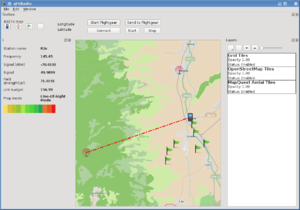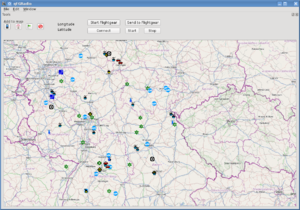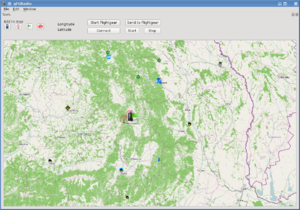QRadioPredict: Difference between revisions
No edit summary |
No edit summary |
||
| Line 11: | Line 11: | ||
===Features=== | ===Features=== | ||
[[Image:qfgradio3.png|thumb|Showing APRS stations]] | |||
[[Image:qfgradio2.png|thumb|Showing APRS stations]] | [[Image:qfgradio2.png|thumb|Showing APRS stations]] | ||
* Placing the mobile station on a 2D map provided by OpenStreetMap, or by open sattelite imagery. | * Placing the mobile station on a 2D map provided by OpenStreetMap, or by open sattelite imagery. | ||
Revision as of 19:13, 3 September 2013
| This project is an external project related to Flightgear. This project is dedicated to humanitarian and radio amateur usage, as well as for increased realism for those who use Flightgear as a training tool. Support for any other type of usage will be granted by the author on a case by case basis. |
Summary
This GUI tool exploits the tremendous connectivity and capabilities of Flightgear. By running the telnet server of Flightgear at 100 Hz, we are pushing the limits of the props server, with great results. Analysis of radio path for site planning and simulation purposes is thus possible by using one mobile station, positioned anywhere in the Flightgear world, and up to three fixed stations, each of them having the principal characteristics like transmit power, antenna gain, antenna height etc. configurable via the interface.
Features
- Placing the mobile station on a 2D map provided by OpenStreetMap, or by open sattelite imagery.
- Placing and configuring up to three fixed stations, which will transmit a signal to the mobile station.
- Setting the path that the mobile station will follow, via waypoints placed on the map.
- Signal and transmission analysis for the radio links, running at the rate at which the simulator itself is running.
- The mobile station will always follow the terrain, if the waypoints have no altitude specified.
- Radio parameters are: transmit power, receiver sensitivity, antenna gain on both parts, cable losses, antenna heights above surrounding terrain, polarization, antenna type (provides radiation patterns, see the main FGRadio article).
- The results are displayed both graphically and as real numbers, on a different tab for each station.
- The Irregular Terrain Model is used with some modifications, as well as the new algorithm designed to calculate losses caused by terrain type (wooded area, city, town, coniferous, mixed forests etc.)
Planned features
- APRS stations displayed on map, and perhaps sent to Flightgear for signal analysis in real time. This should allow practical tests of the algorithm for clutter loss.
- More than one mobile station, as well as messaging between fixed-mobile, fixed-fixed, mobile-mobile.
- More than three fixed stations, with the only limit imposed by the user hardware.
Availability
QFGRadio has not yet reached a state where it can be readily made available. It is beta software for now, in testing. Some issues are known and have to be eliminated. Its function is related to Flightgear, and the program cannot operate by itself, but it is still an external tool. It is intended to be portable across different operating systems. A video showing the operation of the software can be seen here.


